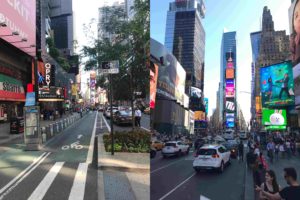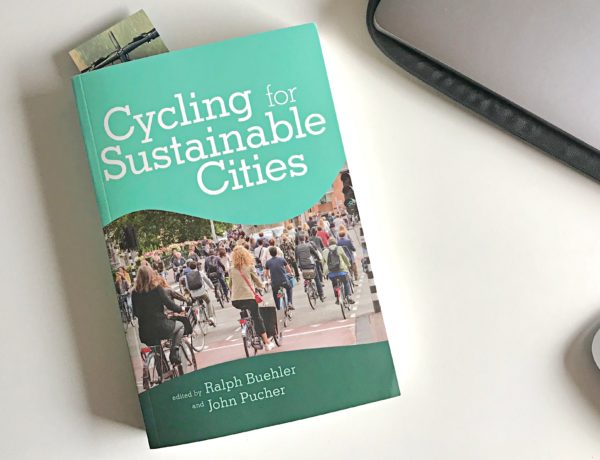English version at the bottom of this page
„Radfahren in New York? Bist Du noch bei Sinnen?“ So, oder so ähnlich kann man die Reaktionen einordnen, wenn es um meine aktuelle „Forschungsreise“ geht. Dennoch: hier tut sich was und in zahlreichen Gesprächen vor Ort, werde ich daran bestätigt. Ja, es ist noch ein Stück Weg zu gehen. Aber in den letzten Jahren hat sich viel getan. Die Fahrradkarte, auf der die zusammen hängenden Abschnitte fertig gestellter und ansprechender Fahrradrouten verzeichnet ist verändert sich von Auflage zu Auflage. Und nach einigen Tage auf dem Rad kann ich sagen: jepp, das ist schön hier Rad zu fahren. Nicht überall und manches ist gewöhnungsbedürftig. Aber es scheint sich zu entwickeln.
Ursache und Wirkung
An irgendeinem Punkt, gab es in NYC eine Wende. Ich treffe niemanden, der es an einem konkreten Punkt fest machen kann. War es der 11. September 2001, der erfolglose Bewerbung um die Olympischen Spiele oder ist der Ausbau der Fahrradinfrastruktur die „Low Hanging Fruit“, um die Stadt umzubauen und ihr ein neues Antlitz zu geben. Was auch immer: irgendetwas hat den Ausschlag gegeben und seither geht es voran.Natürlich ist das Thema Verkehr und Infrastruktur hier ein Dauerbrenner und kontrovers diskutiert – so wie andernorts auf der Welt auch. Aber der Ausbau der Fahrradinfrastruktur folgt einem konkreten Plan und das merkt man auch, wenn man mit dem Rad unterwegs ist.
Nachhaltige Stadtentwicklung
Parallel zum Ausbau der Radrouten, werden auch immer mehr Parks – vor allen Dingen entlang der Flussläufe erschlossen. Insofern scheint die Idee der „Low Hanging Fruits“ gar nicht so weit hergeholt. Ein Umbau der Stadt zu einem Ort mit hohem Aufenthaltswert und urbanen Rückzugsräumen. NYC folgt damit dem Beispiel europäischer Städte wie Kopenhagen oder Utrecht, die diesen Weg erfolgreich bis Ende gegangen sind. Und der Erfolg gibt ihnen recht. In diesen Städten hat sich nachhaltig etwas verändert, noch während die Umgebungsstrukturen angepasst wurden. Warum also nicht auch in der Metropole New York.

Auf Höhe des Riverside Parks trenne sich Rad und Fußweg. Die schöne Anlage ist für Fußgänger, der Schnellweg unter der Straße frisch asphaltiert für Radler.
Auf dem Weg durch die Stadt
Die Voraussetzungen sind günstig und als ich mich auf den Weg mache merke ich schnell: das ganze hat System und es macht vor allen Dingen Spaß. Klar, muss man noch an der einen oder anderen Stelle mit den Lücken im System leben. Wer beispielsweise von der Brooklyn Bridge aus versucht, die Südspitze Manhattan zu erreichen, muss durch das dichte Gewusel des Financial District. Mir macht das Spaß – die meisten anderen Menschen würden Stressflecken bekommen. Darum wird der Radverkehr auch direkt zum Hudson geleitet. Und ist man erst einmal dort, ist es wie „Ferien“.

Die Straßenschluchten von Manhattan mit Ihren Touristen- und Automassen sind nur schwer zu bändigen. Ich mag das ja – für einen Moment
Entlang des Hudson Rivers
Vom Battery Park über Hell´s Kitchen bis hoch zum Riverside Park muss man sich nicht um Autoverkehr kümmern. Hier sind es die Radfahrer, die Rücksicht nehmen müssen. Und zwar auf die teils zahlreichen Fußgänger. Und an manchen Stellen muss man leider schieben – das ist keine Radrennstrecke, aber eine herrlich schöne, urbane Radroute mit Kultcharakter. Parks und Piers wechseln sich ab. Und ein Abstecher in die wuseligen Straßen weiter östlich ist jederzeit möglich. Weiter im Norden – parallel zum Riverside Park, also auf Höhe Central Park – gibt es eigene, separate Radwege, auf denen man schnell und komfortabel voran kommt. Und überall hat man grandiose Aus- und Ansichten.

Die linksseitig geführten Radwege, fahren sich entspannt. Natürlich sind die Kreuzungspunkte eine echte verkehrstechnische Herausforderung
Broadway, Timesquare und weiter
Ich kann nicht anders: ich muss durch die Straßen zurück. Es ist wuselig, es ist laut und unübersichtlich. Man muss aufpassen wie verrückt – sowohl auf den Verkehr, als auch auf den Zustand der Straßen. Im Central Park fahren alle Rad – hier boomt der Fahrradverleih. Aber in die Straßen wagt sich kaum jemand. Obwohl es überall Radrouten gibt – die aber gewöhnungsbedürftig geführt werden. Meist auf der linken Seite, hinzu kommen Einbahnstraßenregelungen und erst nachdem ich den Times Square hinter mir gelassen habe und neu angelegte Bereiche Richtung Hell´s Kitchen erreiche, wird mehr das System klar. Der Radverkehr wird in einer Art Fuhrt links geführt und hat eigene Grünphasen. Der links abbiegende Autoverkehr hat jeweils gegenläufige Signale. Scheint zu funktionieren, bleibt aber gewöhnungsbedürftig.

Gelöst wird die Situation an den Abbiegepunkten durch separate Ampelschaltungen für die Linksabbieger unter den Autofahrern
Zurück in Brooklyn
Durch die Tour in Manhattan wird mir Einiges klarer. Die Fahrten in Brooklyn der letzten Woche ergaben kein zusammenhängendes Bild davon, wohin die Reise in New York gehen soll. Es scheint eine Mischung aus ansprechenden, exklusiv für Radler angelegten Routen, z.B. entlang der Flussläufe und Hauptachsen sowie geschützten Radstreifen mit viel Platz und guter Durchgängigkeit zu sein. Eine durchaus ansprechende Vision, finde ich. Und wenn ich das jetzt so beurteile, ist das Ganze auch schon recht weit gediehen. Ja, es ist noch ein Stück Weg zu gehen. Aber die Ansätze sind schon gut „erfahrbar“.
Hier findest Du Teil 1 einer Serie über Radfahren in NYC
English Version
„Cycling in New York? Are you still in your senses?„ Well, or something like that you can classify the reactions when it comes to my current „research trip „. Nevertheless, here is something going on and in many local discussions, I am confirmed. Yes, there is still a way to go. But a lot has changed in the last few – maybe up to ten – years. The cycling map, on which the hanging sections of completed and attractive bicycle routes is listed changes from one edition to the next. And after a few days on the bike I can say: yeah, that’s nice to ride here. Not everywhere and some things to get used to. But it seems to be developing.
Cause and effect
At some point, there was a turnaround in NYC. I do not meet anyone who can pin it down at a specific point. Was it the September 11, 2001, the unsuccessful application for the Olympic Games or is the expansion of the bicycle infrastructure the „Low Hanging Fruit“ to rebuild the city and give it a new face. Whatever: something has been the key and since then it is progressing. Of course, the topic of transport and infrastructure here is a perennial favorite and controversial – as elsewhere in the world too. But the expansion of the bicycle infrastructure follows a concrete plan and you can tell that even when you’re cycling.
Sustainable urban development
Parallel to the expansion of the cycle routes, more and more parks – especially along the river courses – are being developed. In this respect, the idea of “Low Hanging Fruits“ does not seem so far-fetched. A transformation of the city to a place with high residence value and urban retreats. NYC follows the example of European cities such as Copenhagen or Utrecht, which have successfully completed this path. And success proves them right. In these cities, something has changed sustainably, even while the surrounding structures have been adjusted. Why not in the metropolis of New York?
On the way through the city
The conditions are favorable and as I’m on the way I notice quickly: the whole has system and it is above all fun. Of course, one still has to live with the gaps in the system at one point or another. For example, those who try to reach the southern tip of Manhattan from the Brooklyn Bridge must pass through the dense hustle and bustle of the Financial District. I enjoy it – most other people would get stress spots. That’s why cycling is also routed directly to the Hudson. And once you get there, it’s like „holidays“.
Along the Hudson River
From Battery Park via Hell’s Kitchen to the Riverside Park you do not have to worry about car traffic. Here it is the cyclists who have to consider. And indeed on the sometimes numerous pedestrians. And in some places you have to walk your bike unfortunately – this is not a cycling racetrack, but a wonderfully beautiful, urban bike route with a cult character. Parks and piers take turns. And a detour into the bustling streets further east is possible at any time. Further north – parallel to the Riverside Park, at the height of Central Park – there are separate bike paths, where you can move quickly and comfortably. And everywhere you have great views.
Broadway, Timesquare
I can not help it: I have to go back through the streets. It’s buzzing, it’s loud and confusing. You have to be careful how crazy – on the traffic as well as the condition of the roads. All bikes are in Central Park – the bicycle rental business is booming here. But hardly anyone ventures into the streets. Although there are cycle routes everywhere – but you got to get used to them. Most on the left side, plus one-way street rules, and only after I leave Times Square behind and reach new areas towards Hell’s Kitchen the system becomes clear to me. The bicycle traffic is led in a kind of guidance on the left and has its own green phases. The left-turning car traffic has opposite signals. It seems to work, but it takes some getting used to.
Back in Brooklyn
The tour in Manhattan makes it clearer to me. Last week’s rides in Brooklyn did not give a coherent picture of where to go in New York. There appears to be a mix of responsive routes designed exclusively for cyclists, e.g. along the rivers and main axes as well as protected bicycle lanes with plenty of space and good continuity. A very appealing vision, I think. And if I judge that now, the whole thing has already progressed quite far. Yes, there is still a way to go.



